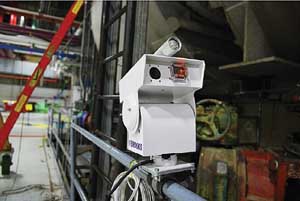Reducing Millirem Exposure
Radioactive materials are clinging to the inside walls of reactor system components because of a noble metals injection process error some years ago at Cooper Nuclear Station (CNS). CNS has launched an aggressive, long-term program to remove the materials, but until the work is successfully completed, the station is also taking extensive measures to protect employees and reduce higher source term dose.
One of the most comprehensive and successful measures for achieving this goal is a sophisticated system of more than 55 cameras — slated to grow to more than 120 cameras. The cameras, supplied by R. Brooks and Associates, view pipe chases and slop drains on the turbine deck and in the heater bay, condenser, reactor feed pump room, steam tunnel, and drywell — anywhere and everywhere higher radiation levels exist during normal plant operation (Figure 7). The cameras are linked via a powerful computer system that enables operators, engineers, technicians, managers, and supervisors to use the computer on their desk or at home to turn on any remote access data system camera at the station and zoom in on a specific component or instrument without entering the reactor containment area.

7. Outside looking in. Cooper Nuclear Station has installed a network of remote data access cameras that allows the plant staff to view equipment and instrumentation inside e reactor containment area, significantly reducing employee radiation doses. Courtesy: Cooper Nuclear Station
"This is a terrific tool for us," said Deet Willis, CNS operations manager. "Since we installed the remote access data system, operators have been able to make virtual rounds in high radiation areas without picking up any dose. The remote access data system cameras have powerful lights and sharp zoom lens, so operators can see anything with them just as well as they could if they were standing right next to the component."
The remote access data system also has saved the maintenance staff from unnecessary radioactive exposure. "In the old days," explained Tom Carson, maintenance manager, "it was possible to figure out approximately where leaks were, but it was not easy to know how large the leak was, or exactly what was leaking. So, we’d send a valve tech into the area to get a closer look. But now, since these remote access data system cameras are so sharp and clear and can be controlled precisely from any computer at the station that has access rights to the system, a mechanic can sit in the shop and closely examine a leak. We can see exactly where the leak is and why the leak has occurred. We are able to accurately plan repair work in a high radiation area without anyone picking up any dose whatsoever."
"Not only are there dose savings," notes Mike Colomb, general manager of plant operations, "the remote access data system cameras have given us the ability to maintain high safety margins, by letting us lay electronic eyes on things from the control room while the plant is at full operation. Dose reduction gave us the powerful incentive to make the large investment needed to install the remote monitoring system, but being able to better monitor components and equipment at full power has resulted in a payback well beyond dose reduction."
— Contributed by Glen Troester of Nebraska Public Power District (NPPD). NPPD is the owner of the Cooper Nuclear Station. Portions of this article originally appeared in the fall 2008 issue of USA Inside, a Utilities Service Alliance publication.